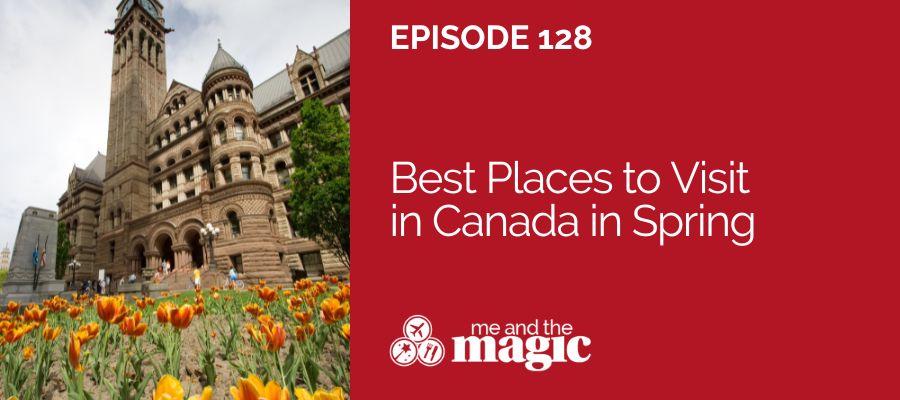In this episode, we explore the best places to visit in Canada, particularly in the spring when the snow is melting, the flowers are blooming, and the maple syrup is being harvested!
Canada Geography and Climate
Canada shares its southern border with the United States and also its northwest border with the state of Alaska. Greenland shares a border to the northeast on Hans Island with the Nunavut Canadian territory. To the east is the Atlantic Ocean; to the west, the Pacific Ocean; and to the north, the Arctic Ocean. Canada has the longest coastline in the world, and its border with the US is the world’s longest land border. Canada is the second largest country in the world by total area, after Russia. By comparison, the United States is the fourth largest country in the world, after China. But Canada has so much freshwater, making up 8.9% of its total area, that if you only take into account its land area, it’s the fourth largest behind Russia, then China, then the US. Canada has 13 provinces and territories. Because Canada is so large, the temperatures have a big range. Some areas have snow 6 months out of the year. In some provinces, winter temperatures average -15 degrees C (5 degrees F) but can drop to -40 degrees C (-40 degrees F). British Columbia to the west has beautiful spring weather, ranging from 7-17 degrees C (45-65 degrees F). this year, El Nino has helped cause a milder winter that will lead into higher than normal spring temperatures across Canada.
Spring Destinations and Activities in Canada
Canada overall has the most visitors in summer months, so visiting March to June is considered a shoulder season, which likely means less crowds and lower costs.
Snow Skiing in Spring
In some parts of Canada, ski resorts stay open until April, or even out west larger resorts like Whistler, Lake Louise, and Sunshine, until May. Here’s why spring skiing may be a great option: longer daylight hours; slopes that aren’t as busy, warmer temperatures, softer snow, and great deals on tickets and accommodations.
Waterfalls and Nature in Spring
Guess where a lot of that melting snow goes? Into rivers and over waterfalls! Of course, the snow melt varies depending on climate. For example, Vancouver Island in British Columbia will see a big increase in water level as snow melts in March. In higher, colder climates, the snow melt may not happen until closer to June.
The Wells Gray Provincial Park in BC has 41 waterfalls.
When you think of waterfalls, what’s the first one that comes to mind? How about Niagara Falls, the magnificent waterfalls that straddle the Canadian border with New York state. With the snow melt, the falls are at their most active in the spring. Also, visit Queen Victoria Park along the Niagara River, spring being a perfect time to enjoy the new blooms.
Maple Syrup Harvest
Are you a fan of maple syrup? (Who’s not?) Canada has the largest maple syrup industry in the world, and harvest time runs from mid-February through April. According to the website OffTrackTravel.ca, “Maple farms across Quebec, Ontario and New Brunswick (plus a scattering across every province) celebrate the start of the season by offering delicious maple-themed breakfasts, maple taffy on snow, sugar-making demonstrations, woodland wagon rides and more.”
British Columbia
Vancouver, British Columbia has been at the top of my travel wish list for quite some time. In the spring, enjoy the cherry blossoms in this beautiful city. The city’s cherry blossom trees were donated a century ago by Japan to honor the Japanese Canadian veterans who fought in World War I. Vancouver holds an annual Cherry Blossom Festival. This year, it will be March 29th to April 25th. There are all kinds of events planned as part of this festival, including a big picnic, a Sakura Days Japan Fair, tree walks, biking events, and more. Also, explore Stanley Park as flowers come into bloom.
Victoria is at the southern end of Vancouver Island and is the capital of the British Columbia province. Victoria is known as the “City of Gardens” and comes alive in the spring with all the fresh blooms and vibrant colors. Visit the Butchart Gardens and Beacon Hill Park. In March, visit the Greater Victoria Flower Count, where communities are encouraged to stop and count all the beautiful flowers surrounding them.
Not to be missed is the whale watching. From VancouverIsland.com: “Each spring, some 20,000 Gray Whales move past the western shore of Vancouver Island, en route to summer feeding grounds in the Bering Sea. The 30 ton giants can be seen from shore, as early as February, with females and calves passing in April and early May. They return by the same route in the fall, to their calving and wintering areas in the lagoons of Baja California.”
Alberta
The city of Banff and Banff National Park in Alberta are great in the spring, with the snow melting off the Rocky Mountains. Hike along Fenland Trail, Sundance Canyon and the Bow River Trail. Watch for lots of wildlife, including moose, goats, elk, and bears. Take the gondola up Sulphur Mountain, and enjoy a dip in the Upper Banff Hot Springs. The ice melts on Lake Louise, and the lake turns its beautiful turquoise color that it’s known for.
Ontario
Ottawa, Ontario is known for its tulips in the spring. When I think of tulips, I think of Holland and the Netherlands, but Ottawa actually has the world’s largest tulip festival. Every year, the Canadian Tulip Festival is held in Centennial Park. This year, it’s May10th through 20th. And this is an interesting piece of history – tulip bulbs have been gifted to Canada every year since WWII in thanks for sheltering the Dutch Royal Family. The tulip festival photos look gorgeous, hundreds of thousands of tulips to enjoy, and admission is free. Ottawa is also home to the National Gallery of Canada. Also, enjoy the ByWard market, one of Canada’s oldest and largest markets for shopping and eating. You’ll also find many maple syrup treats in Ottawa, in the springtime especially.
Quebec
Quebec City, Quebec sits along the St. Lawrence River. Walk down the cobblestone streets of Old Quebec and feel like you’ve been transported to a centuries-old French village. Explore the city’s parks for blooming tulips and other flowers. Visit a sugar shack. Spring is sugaring-off season, and a visit to a traditional sugar shack in the surrounding countryside is a quintessential Quebec experience. Enjoy maple syrup on snow, traditional meals, and learn about the maple syrup production process.
Visit Montmorency Falls: Just a short drive from the city, the Montmorency Falls are higher than Niagara Falls and offer a spectacular sight, especially when the snow and ice start to melt. You can take a cable car up, walk along the suspension bridge, and explore the surrounding park.
Nova Scotia
Annapolis Valley, Nova Scotia – known for its flower blooms, apple orchards, and vineyards. Visit Harriet Irving Botanical Gardens and the Annapolis Royal Historic Gardens. The Apple Blossom Festival is held in May.
New Brunswick
Would you like to see ice on a frozen ocean break apart? In the Bay of Chaleur in Northeastern New Brunswick, the ocean is frozen for around four months. As temperatures increase, the ice starts to separate and forms floating platforms. Of course, it may be hard to predict exactly when that’s going to occur if you want to plan a trip to see it, but the month of April is a pretty safe bet to catch this site.
Newfoundland and Labrador
St. Johns, Newfoundland and Labrador are just off the Atlantic Coast. During the spring, watch for humpback whales and puffins. And check out Iceberg Alley all along the coast for icebergs mostly coming from broken edges of glaciers from western Greenland.
This fun website has great info on viewing icebergs and on icebergs in general. You can even use your cursor to draw an iceberg, then it shows you how that iceberg would float.
Resources
Learn more about Iceberg Alley, icebergs and draw an iceberg to see how it floats at NewfoundLabrador.com.

